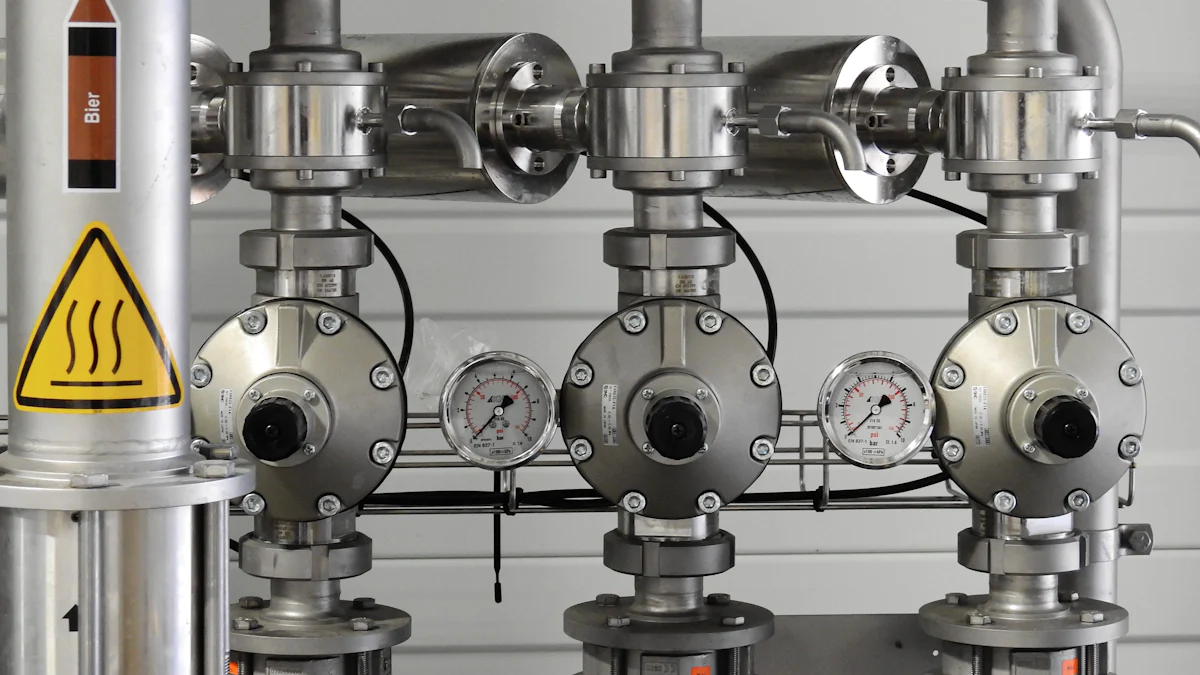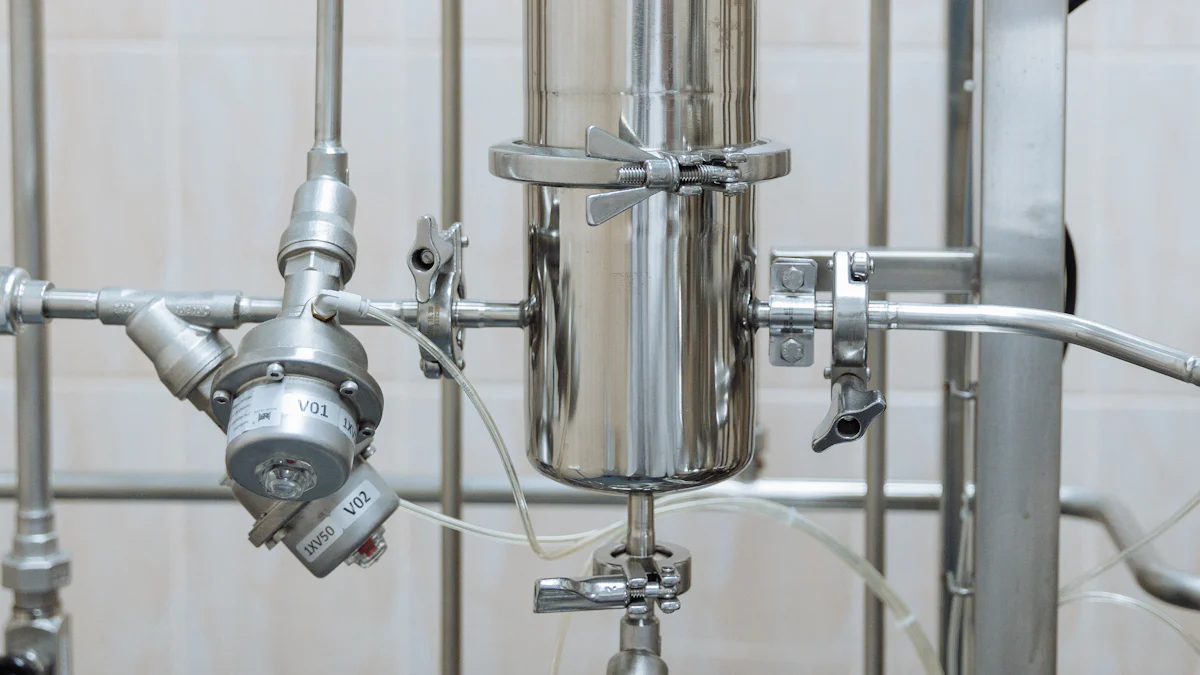FEP Heat Shrink Tubing vs PTFE for Chemical Resistance

Chemical resistance plays a vital role in selecting materials for demanding environments. Industries rely on materials that can withstand exposure to harsh acids, bases, and solvents without degrading. Fluoropolymers like FEP and PTFE excel in this regard, offering exceptional resistance to a wide range of chemicals. FEP Heat Shrink Tubing for Chemical Resistance stands out for its flexibility, transparency, and ease of processing. PTFE, however, surpasses FEP in handling extreme chemical environments and higher temperatures. Understanding these differences helps in choosing the right material for specific applications.
Overview of FEP and PTFE
FEP Heat Shrink Tubing for Chemical Resistance
Chemical composition and structure
FEP, or Fluorinated Ethylene Propylene, is a fluoropolymer derived from PTFE. Its chemical structure consists of carbon and fluorine atoms, similar to PTFE, but with slight modifications that make it melt-processable. This unique composition allows FEP to be reshaped and welded into complex forms, which is not possible with PTFE. The material exhibits excellent resistance to most industrial chemicals, including acids, bases, and solvents. Its non-reactive nature ensures durability in harsh environments, making it a reliable choice for applications requiring chemical resistance.
General properties and common applications
FEP heat shrink tubing for chemical resistance offers several notable properties. It operates effectively at temperatures up to 200°C, providing thermal stability in moderate heat conditions. Its flexibility and transparency set it apart from other fluoropolymers, enabling visual monitoring of enclosed components. Additionally, FEP resists UV radiation and sunlight, making it suitable for outdoor use. Industries often utilize FEP in applications such as wire insulation, fluid handling systems, and medical devices. Its ease of processing and ability to form intricate shapes make it a preferred material for heat shrink tubing and other specialized products.
PTFE
Chemical composition and structure
PTFE, or Polytetrafluoroethylene, is a high-performance fluoropolymer composed entirely of carbon and fluorine atoms. Its tightly bonded molecular structure gives it exceptional chemical inertness, allowing it to withstand exposure to highly corrosive substances. PTFE's non-stick surface and low friction coefficient further enhance its versatility. Unlike FEP, PTFE cannot be melt-processed, but its higher melting point and broader temperature range make it ideal for demanding applications.
General properties and common applications
PTFE stands out for its ability to endure extreme temperatures, operating continuously at up to 260°C. Its resistance to nearly all chemicals, combined with excellent electrical insulation properties, makes it indispensable in industries like aerospace, semiconductors, and chemical processing. PTFE's durability and non-reactive nature make it the material of choice for seals, gaskets, and linings in environments with aggressive chemicals. While it lacks the transparency and flexibility of FEP, PTFE excels in applications requiring superior chemical resistance and thermal stability.
Detailed Comparison of FEP and PTFE

Chemical Resistance
Resistance to acids, bases, and solvents
Both FEP and PTFE exhibit remarkable chemical resistance, making them ideal for environments exposed to harsh substances. FEP resists a wide range of acids, bases, and solvents, ensuring durability in industrial applications. Its chemical makeup allows it to maintain integrity when exposed to corrosive agents. PTFE, however, surpasses FEP in this category. Its superior chemical inertness enables it to withstand highly aggressive chemicals, including concentrated acids and strong oxidizers, without degradation. This makes PTFE the preferred choice for applications requiring excellent chemical resistance in extreme conditions.
Performance in extreme chemical environments
FEP performs well in most chemical environments but has limitations in highly corrosive settings. Its slightly higher reactivity compared to PTFE makes it less suitable for handling the most aggressive chemicals. PTFE, on the other hand, thrives in extreme chemical environments. Its non-reactive nature and tightly bonded molecular structure provide unmatched resistance to chemical attacks. Industries dealing with hazardous substances often rely on PTFE for seals, gaskets, and linings to ensure long-term performance and safety.
Thermal Properties
Operating temperature ranges
FEP operates effectively at temperatures up to 200°C, making it suitable for moderate heat applications. Its thermal stability ensures consistent performance within this range. PTFE offers a broader temperature range, with continuous operation possible at up to 260°C. This higher threshold allows PTFE to excel in high-temperature environments where FEP would fail. Applications requiring exposure to extreme heat often favor PTFE due to its superior thermal properties.
Thermal stability and degradation
FEP demonstrates reliable thermal stability within its operating range. It resists degradation under moderate heat, maintaining its structural integrity. However, prolonged exposure to temperatures beyond its limit can cause melting and loss of functionality. PTFE exhibits exceptional thermal stability, even under extreme conditions. Its resistance to thermal degradation ensures durability in demanding applications, such as aerospace and chemical processing, where consistent performance is critical.
Mechanical Properties
Flexibility and tensile strength
FEP stands out for its flexibility, which allows it to adapt to complex shapes and configurations. This property makes it a popular choice for applications requiring pliability, such as medical tubing and wire insulation. PTFE, while less flexible, compensates with higher tensile strength. Its robust structure provides greater resistance to mechanical stress, making it suitable for heavy-duty applications where durability is essential.
Wear resistance and durability
FEP offers moderate wear resistance, performing well in environments with minimal mechanical abrasion. Its softer composition, however, makes it less durable under constant friction or heavy loads. PTFE excels in wear resistance, withstanding abrasive forces and maintaining its properties over time. Its durability ensures reliable performance in applications involving repeated mechanical stress, such as seals and bearings.
Other Relevant Characteristics
Transparency and Optical Clarity
FEP surpasses PTFE in transparency and optical clarity, making it the preferred choice for applications requiring visibility. Its ability to transmit light effectively allows users to monitor enclosed components or fluids without obstruction. This feature proves especially valuable in industries like medical and laboratory equipment, where visual inspection is critical.
PTFE, in contrast, lacks the same level of transparency. Its opaque nature limits its use in scenarios where visibility is essential. While PTFE excels in chemical resistance and thermal stability, its optical properties fall short compared to FEP. The enhanced clarity of FEP, combined with its resistance to UV radiation and sunlight, makes it suitable for outdoor applications exposed to environmental elements.
Ease of Processing and Installation
FEP offers significant advantages in processing and installation due to its thermoplastic nature. Unlike PTFE, which cannot be melt-processed, FEP can be reshaped and welded into complex forms. This characteristic simplifies manufacturing and enables the creation of intricate designs, such as heat shrink tubing. Its softer composition and lower melting point further enhance its processability, allowing for easier handling during installation.
PTFE, while more durable, presents challenges in processing. Its inability to melt-process requires alternative fabrication methods, which can increase production complexity and cost. Despite these limitations, PTFE remains a reliable choice for applications demanding superior chemical and thermal performance. However, for projects prioritizing ease of use and adaptability, FEP provides a more practical solution.
Practical Applications and Use Cases

When to Choose FEP Heat Shrink Tubing
Applications requiring transparency and flexibility
FEP tubing proves invaluable in scenarios where visibility and adaptability are essential. Its transparency allows users to monitor fluids or components enclosed within the tubing, making it a preferred choice in industries like chemical processing and medical equipment manufacturing. For example, in fluid handling systems, FEP tubing enables clear observation of liquid flow, enhancing safety and operational efficiency. Its flexibility further supports intricate designs, such as those required in aerospace wiring or medical devices, where precise configurations are necessary.
The ability to melt-process FEP into complex shapes adds to its versatility. Unlike PTFE, FEP can be reshaped and welded, simplifying manufacturing processes. This property makes FEP heat shrink tubing an excellent option for applications that demand both adaptability and ease of installation. Its UV resistance also makes it suitable for outdoor use, ensuring durability under prolonged sunlight exposure.
Scenarios with moderate temperature requirements
FEP tubing performs reliably in environments with moderate temperature demands. Its maximum operating temperature of 200°C ensures stability in many industrial and commercial applications. For instance, in electrical insulation, FEP provides thermal protection without compromising its structural integrity. However, its lower melting point compared to PTFE limits its use in high-temperature settings.
Industries such as food processing benefit from FEP's non-stick and chemically inert properties. Coating equipment with FEP ensures hygiene and prevents contamination, even under moderate heat. These characteristics make FEP heat shrink tubing a practical solution for applications where high temperature resistance is not a primary concern but chemical resistance and flexibility are critical.
When to Choose PTFE
Applications requiring extreme chemical resistance
PTFE tubing stands out in environments exposed to aggressive chemicals. Its exceptional chemical resistance allows it to endure concentrated acids, strong oxidizers, and other corrosive substances without degradation. Industries like chemical processing and semiconductor manufacturing rely on PTFE liners and tubing to maintain safety and performance in harsh conditions.
PTFE's non-reactive nature makes it indispensable for seals, gaskets, and linings in extreme chemical environments. For example, PTFE liners in storage tanks prevent chemical reactions that could compromise the tank's integrity. This level of protection ensures long-term reliability, even in the most demanding applications.
Scenarios with high-temperature demands
PTFE excels in applications requiring high temperature resistance. Its ability to operate continuously at temperatures up to 260°C makes it ideal for aerospace, automotive, and industrial settings. For instance, PTFE tubing is commonly used in heat exchangers and high-temperature fluid transfer systems, where other materials would fail.
The durability of PTFE under extreme heat ensures consistent performance over time. Its thermal stability and resistance to degradation make it a superior choice for applications where temperature fluctuations are frequent. While PTFE lacks the transparency and flexibility of FEP, its unmatched thermal and chemical properties make it the material of choice for high-stress environments.
FEP and PTFE each offer unique advantages, making them suitable for different applications. FEP stands out for its transparency, flexibility, and ease of processing. It performs well in moderate temperature environments and applications requiring visibility, such as medical tubing or fluid handling systems. PTFE, on the other hand, excels in extreme chemical resistance and high-temperature stability, making it indispensable for demanding industries like aerospace and chemical processing.
When selecting between the two, consider the specific requirements of the application. For projects prioritizing adaptability and clarity, FEP is ideal. For environments with aggressive chemicals or extreme heat, PTFE provides unmatched durability and performance.
FAQ
What is the difference between FEP and PTFE?
FEP, or Fluorinated Ethylene Propylene, is a melt-processable version of PTFE (Polytetrafluoroethylene). While both materials share similar properties, such as excellent chemical resistance and low friction, FEP can be reshaped and welded into complex forms due to its thermoplastic nature. PTFE, on the other hand, cannot be melt-processed but offers a higher maximum operating temperature of up to 260°C, compared to FEP's limit of 200°C.
What are the unique properties of FEP compared to PTFE?
FEP stands out for its ability to be melt-processed, enabling it to be extruded and molded into intricate shapes. It also offers superior transparency, making it ideal for applications requiring visibility, such as fluid monitoring systems. While PTFE provides better performance in extreme temperatures and highly corrosive environments, FEP excels in flexibility, ease of processing, and UV resistance.
What are the thermal and chemical properties of FEP and PTFE?
Both FEP and PTFE exhibit exceptional chemical resistance, making them suitable for handling acids, bases, and solvents. However, PTFE outperforms FEP in extreme chemical environments due to its superior inertness. In terms of thermal properties, PTFE operates at higher temperatures, up to 260°C, while FEP is limited to 200°C. FEP compensates with its flexibility and ease of use in moderate temperature applications.
What industries commonly use FEP and PTFE?
FEP and PTFE find applications across various industries. PTFE is indispensable in aerospace and chemical processing, where components must endure extreme conditions. It is often used for seals, gaskets, and high-temperature hoses. FEP is popular in the chemical processing industry for lining reactors and piping, as well as in fluid handling systems requiring visual monitoring. Both materials are widely used in the electrical industry for wire and cable coatings, enhancing safety and reliability.
When should FEP heat shrink tubing be used?
FEP heat shrink tubing is ideal for applications requiring transparency and flexibility. It allows users to monitor enclosed components or fluids, making it valuable in medical devices and fluid handling systems. Its UV resistance also makes it suitable for outdoor applications. Additionally, FEP performs well in moderate temperature environments, providing thermal stability up to 200°C.
When is PTFE the better choice?
PTFE is the preferred material for applications demanding extreme chemical resistance or high-temperature stability. It excels in environments exposed to concentrated acids, strong oxidizers, or temperatures up to 260°C. Industries such as aerospace, automotive, and chemical processing rely on PTFE for its durability and performance under harsh conditions.
Can FEP and PTFE be used interchangeably?
While FEP and PTFE share many properties, they are not always interchangeable. FEP is better suited for applications requiring flexibility, transparency, and ease of processing. PTFE, however, is the superior choice for extreme chemical resistance and high-temperature environments. The specific requirements of the application should guide the selection.
How does the transparency of FEP benefit certain applications?
FEP's transparency allows users to visually monitor fluids or components within the tubing. This feature proves essential in industries like medical equipment manufacturing and chemical processing, where visibility enhances safety and operational efficiency. PTFE, being opaque, lacks this advantage, making FEP the preferred choice for applications requiring optical clarity.
What makes FEP easier to process than PTFE?
FEP's thermoplastic nature enables it to be melt-processed, reshaped, and welded into complex forms. This property simplifies manufacturing and allows for the creation of intricate designs, such as heat shrink tubing. PTFE, in contrast, cannot be melt-processed, requiring alternative fabrication methods that increase production complexity.
Are FEP and PTFE environmentally resistant?
Both FEP and PTFE exhibit excellent resistance to environmental factors. FEP resists UV radiation and sunlight, making it suitable for outdoor use. PTFE, while less UV-resistant, offers unmatched durability in chemically aggressive and high-temperature environments. Both materials provide long-term reliability in challenging conditions.
See Also
The Importance of Ultra-Thin PET Tubing in Healthcare
New Developments in PTFE Liners for Medical Applications
Selecting the Ideal PTFE Etched Liner for Your Needs

